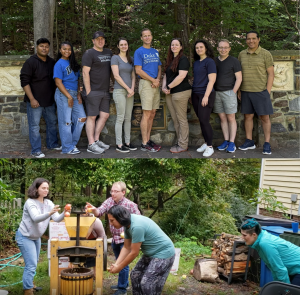what we do
At our secret headquarters in room A304 of the Levine Science Research Center on the Duke University campus in Durham, North Carolina, we use the nematode Caenorhabditis elegans, a versatile model organism, as well as cells in culture in experiments aimed at improving environmental health. Our efforts range from studying the effects of environmental stressors at the molecular and cellular level to effects on the organism as a whole. We have a special interest in mitochondria, and mitochondrial and nuclear DNA damage. By collaborating with other researchers, we also study environmental health in people, other model organisms, and ecosystems.
If you are unfamiliar with environmental toxicology, mitochondria and mitochondrial DNA, or C. elegans (“worms”) and would like a short introduction, click the links below.
why we do it
Science is really fascinating and fun. But there is another reason. Pollution is a major health problem, especially in parts of the world with less environmental protection. It is responsible for at least 9 million premature deaths per year, more than AIDS, tuberculosis, and malaria combined. Most of this results from chronic disease, which will increase as the world’s population lives longer. Such diseases (cancers, neurodegenerative diseases, etc.) are also influenced by genetics, but genetics alone explains only 15-30% of most chronic diseases.
how we do it

We have joined forces with other Duke ecoteams to battle eco-evil:
- The Nicholas School of the Environment
- Duke University Superfund Research Center
- The Integrated Toxicology and Environmental Health Program (ITEHP)
- The Duke Global Health Institute
- Civil and Environmental Engineering
Including regional groups:
- Genetics and Environmental Mutagenesis Society
- Carolinas Society of Environmental Toxicology and Chemistry
- North Carolina Society of Toxicology
- Triangle Mito Club (email Dillon King at NIEHS for details)
publications
Here are some recent publications from our band of green crimefighters. For a full list, please go to Dr. Meyer’s Google Scholar profile (best option; automatically updated except those pesky BioRxiv preprints, which linger on as such), his NCBI Bibliography (https://www.ncbi.nlm.nih.gov/myncbi/joel.meyer.1/bibliography/public/ ; includes publications that aren’t really his but are automatically associated with him because he directs a training grant), or his CV at his NSOE site (updated roughly annually).
Assessment of developmental neurotoxicology-associated alterations in neuronal architecture and function using Caenorhabditis elegans. ALTEX – Alternatives to Animal Experimentation 2025
Complex I superoxide anion production is necessary and sufficient for Complex I inhibitor-induced dopaminergic neurodegeneration in Caenorhabditis elegans. Redox Biology 2025.
Bioenergetic function is decreased in peripheral blood mononuclear cells of veterans with Gulf War Illness. PLOS ONE 2023.
Chronic high-sugar diet in adulthood protects Caenorhabditis elegans from 6-OHDA induced dopaminergic neurodegeneration. BMC Biology 2023.
Resistance of mitochondrial DNA to cadmium and Aflatoxin B1 damage-induced germline mutation accumulation in Caenorhabditis elegans. Nucleic Acids Research 2022.
Mild pentachlorophenol-mediated uncoupling of mitochondria depletes ATP but does not cause an oxidized redox state or dopaminergic neurodegeneration in Caenorhabditis elegans. Current Research in Toxicology 2022.
Early-life mitochondrial DNA damage results in lifelong deficits in energy production mediated by redox signaling in Caenorhabditis elegans. Redox Biology 2021.
Xenobiotic metabolism and transport in Caenorhabditis elegans. Journal of Toxicology and Environmental Health, Part B 2021.
Mitochondrial toxicity. Toxicological Sciences, 2018.
Mitochondrial fusion, fission, and mitochondrial toxicity. Toxicology, 2017.
helpful resources
This page contains a variety of resources, intended especially for members of my own lab but also potentially useful to other scientists or people interested in science.
contact us
Feel free to contact us by the traditional means (or you can always just light the Worm Beacon).

